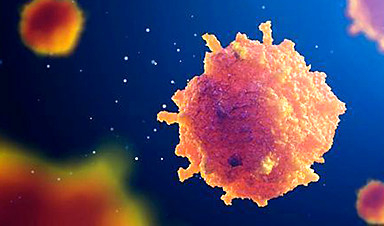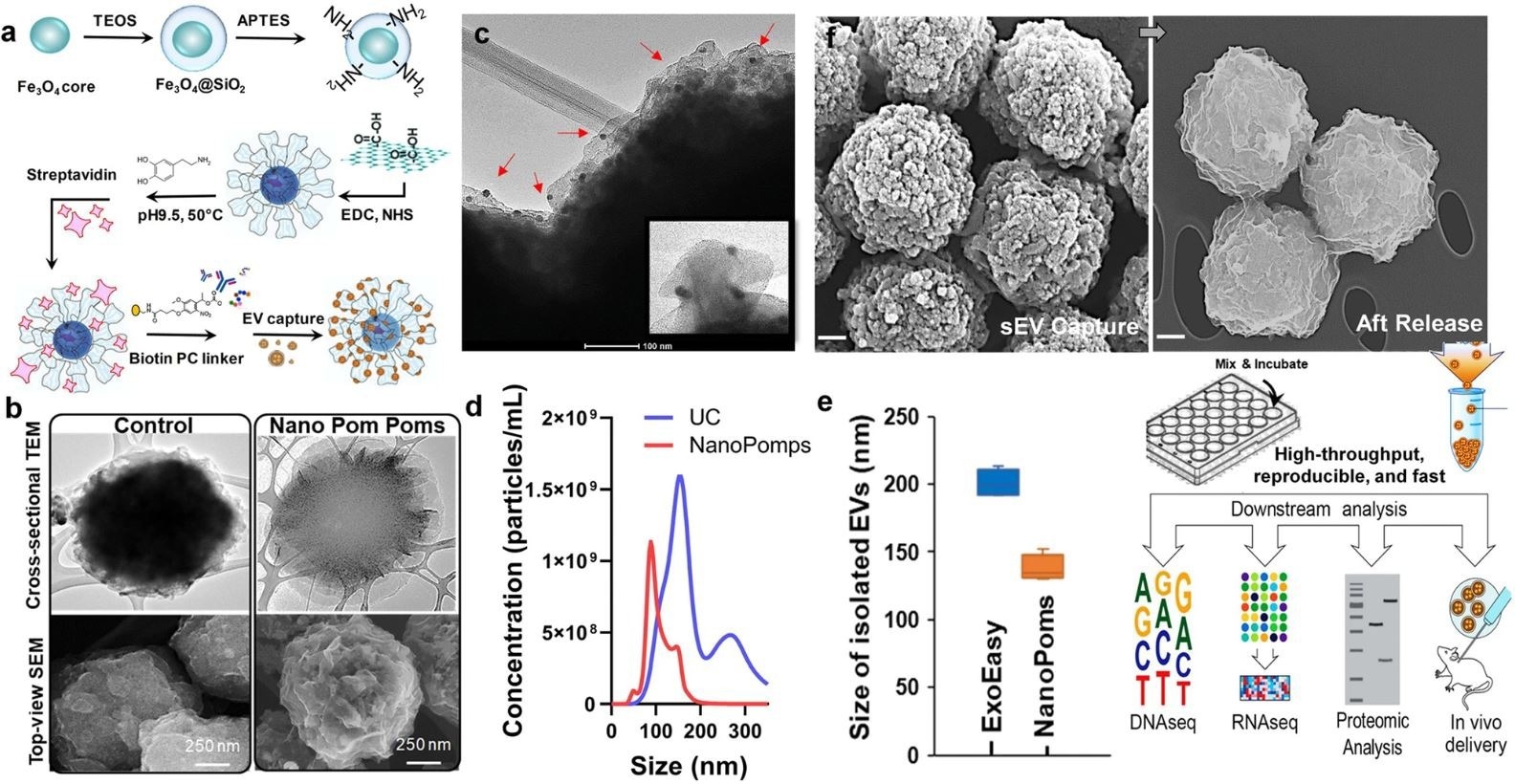Nanosized extracellular vesicle (EV) exosomes serve as reliable biomarker sources. However, cancer biomarker identification through exosome multi-omic molecular information mapping is challenging due to heterogeneous populations of exosomes derived from diverse cell types.
In an article published in the journal Communications Biology, researchers introduced novel three-dimensional (3D) nanographene immunomagnetic particles for specific capture and release (defined by marker) of the intact exosome. The designed novel 3D-structured nanographene particles had a unique morphology of flower pom-poms.
Moreover, the capture and release of intact exosomes were via photo-click chemistry. This exosome isolation approach allowed the identification of cancer biomarkers with enhanced sensitivity and specificity. The multi-omic exosome analysis for cancer biomarker identification was performed using tissue fluids obtained from a bladder cancer patient.
The nanographene immunomagnetic particles prepared exosomes showed a distinct in vivo biodistribution, indicating integral quality with high viability. This nanographene immunomagnetic particles-based technique is a facile approach applicable to various biological fluids. Amending the developed method facilitates scale-up, enrichment, and high-throughput exosome isolation.
What are Cancer Biomarkers?
Despite continuous efforts to develop cancer biomarkers, only a few are approved clinically by the United States Food and Drug Administration (USFDA), including progesterone receptor (PR), human epidermal growth factor receptor 2 (HER-2/neu), cancer antigen 125 (CA-125), and prostate-specific antigen (PSA).
EVs are emerging biomarker sources explored to discover a wide range of cancer biomarkers to achieve cancer diagnosis, drug target and delivery, and immunotherapy. Exosome-type small EVs and their molecular components are associated with various physiological functions and disease pathologies. The exosomes are secreted from tumor cells and are enriched with tumor markers. Consequently, their presence increases in plasma and ascites of the patients diagnosed with cancer.
Body fluids contain different types of EVs. Hence, cellular-specific homogenous exosome populations are not attainable. The cell-secreted membrane vesicles (EVs) are heterogeneous in origin, present in multiple subpopulations, in the broad size range of 30 to 1000 nanometers. Thus, due to the heterogenicity in vesicles and their overlapping size ranges, the exact cellular origin of the exosomes cannot be identified to understand the disease pathogenesis.
The existing purification methods utilized to recover extracellular materials (EMs) with vesicle or non-vesicular molecules include ultracentrifugation-based (UC) precipitation and precipitation polymer kits. However, these approaches are not scalable, and the exosome populations originating from different cell types or EV subtypes cannot be differentiated. Studying cancer biomarkers from exosomes derived from cancer cells is therefore challenging.
Nanographene Exosomes Towards Specific Cancer Biomarker Detection
The present study demonstrated a novel approach for specific capture and release of the intact exosomes that utilizes 3D-structured nanographene immunomagnetic particles. These nanographene immunomagnetic particles have a flower pom poms-like morphology, and the exosome capture and release mechanisms were based on photo-click chemistry.
The intact exosomes for the present study were isolated from different biological fluids, including human urine and blood, cow milk, and cell culture medium. Furthermore, the isolation of exosomes via nanographene immunomagnetic particles facilitated the effective identification of cancer biomarkers with high sensitivity and specificity compared to those isolated via immunomagnetic beads.
The in vivo biodistribution was tested for the exosomes released from nanographene immunomagnetic particles. The results showed distinct biodistribution patterns with insignificant alterations in surface properties of the exosomes, implying the potential of nanographene immunomagnetic particles in therapeutic development.
The exosomes derived from bladder cancer tissue fluids (urine and plasma) were compared with those derived from tumor tissues by next-generation sequencing (NGS) of miRNAs, global proteome, and somatic DNA mutations to achieve an invasive and ultra-sensitive diagnosis of bladder cancer.
The results revealed that compared to ultracentrifugation or bead isolation approaches, exosomes isolated from nanographene immunomagnetic particles showed improved sensitivity and specificity toward detecting urological tumor biomarkers.
The impact of external stimuli like the light release was observed on exosome isolation via a nanographene immunomagnetic particles-based approach in which miRNA profiles were compared in the presence and absence of the light release process. The light release process exhibited specificity by only releasing captured exosomes. These observations confirmed the quality and integrity of nanographene immunomagnetic particles-prepared exosomes as a robust and facile method.
What did the Study Find?
To summarize, the exosome isolation via nanographene immunomagnetic particles-based method was applied to various biological fluids, including human urine and blood, cell culture medium, and cow’s milk. This isolation method was simple and did not require an additional ultracentrifugation process.
The 3D structure of nanographene immunomagnetic particles and the regulated capture-release process by specific markers helped prepare homogenous exosome subpopulations that could enrich the cancer biomarkers.
The NGS and droplet digital polymerase chain reaction (ddPCR) demonstrated that DNA isolation from nanographene immunomagnetic particles-prepared exosomes could be enriched for DNA mutations in bladder cancer-relevant tumors and help in cancer biomarker identification.
News
Platelet-inspired nanoparticles could improve treatment of inflammatory diseases
Scientists have developed platelet-inspired nanoparticles that deliver anti-inflammatory drugs directly to brain-computer interface implants, doubling their effectiveness. Scientists have found a way to improve the performance of brain-computer interface (BCI) electrodes by delivering anti-inflammatory drugs directly [...]
After 150 years, a new chapter in cancer therapy is finally beginning
For decades, researchers have been looking for ways to destroy cancer cells in a targeted manner without further weakening the body. But for many patients whose immune system is severely impaired by chemotherapy or radiation, [...]
Older chemical libraries show promise for fighting resistant strains of COVID-19 virus
SARS‑CoV‑2, the virus that causes COVID-19, continues to mutate, with some newer strains becoming less responsive to current antiviral treatments like Paxlovid. Now, University of California San Diego scientists and an international team of [...]
Lower doses of immunotherapy for skin cancer give better results, study suggests
According to a new study, lower doses of approved immunotherapy for malignant melanoma can give better results against tumors, while reducing side effects. This is reported by researchers at Karolinska Institutet in the Journal of the National [...]
Researchers highlight five pathways through which microplastics can harm the brain
Microplastics could be fueling neurodegenerative diseases like Alzheimer's and Parkinson's, with a new study highlighting five ways microplastics can trigger inflammation and damage in the brain. More than 57 million people live with dementia, [...]
Tiny Metal Nanodots Obliterate Cancer Cells While Largely Sparing Healthy Tissue
Scientists have developed tiny metal-oxide particles that push cancer cells past their stress limits while sparing healthy tissue. An international team led by RMIT University has developed tiny particles called nanodots, crafted from a metallic compound, [...]
Gold Nanoclusters Could Supercharge Quantum Computers
Researchers found that gold “super atoms” can behave like the atoms in top-tier quantum systems—only far easier to scale. These tiny clusters can be customized at the molecular level, offering a powerful, tunable foundation [...]
A single shot of HPV vaccine may be enough to fight cervical cancer, study finds
WASHINGTON -- A single HPV vaccination appears just as effective as two doses at preventing the viral infection that causes cervical cancer, researchers reported Wednesday. HPV, or human papillomavirus, is very common and spread [...]
New technique overcomes technological barrier in 3D brain imaging
Scientists at the Swiss Light Source SLS have succeeded in mapping a piece of brain tissue in 3D at unprecedented resolution using X-rays, non-destructively. The breakthrough overcomes a long-standing technological barrier that had limited [...]
Scientists Uncover Hidden Blood Pattern in Long COVID
Researchers found persistent microclot and NET structures in Long COVID blood that may explain long-lasting symptoms. Researchers examining Long COVID have identified a structural connection between circulating microclots and neutrophil extracellular traps (NETs). The [...]
This Cellular Trick Helps Cancer Spread, but Could Also Stop It
Groups of normal cbiells can sense far into their surroundings, helping explain cancer cell migration. Understanding this ability could lead to new ways to limit tumor spread. The tale of the princess and the [...]
New mRNA therapy targets drug-resistant pneumonia
Bacteria that multiply on surfaces are a major headache in health care when they gain a foothold on, for example, implants or in catheters. Researchers at Chalmers University of Technology in Sweden have found [...]
Current Heart Health Guidelines Are Failing To Catch a Deadly Genetic Killer
New research reveals that standard screening misses most people with a common inherited cholesterol disorder. A Mayo Clinic study reports that current genetic screening guidelines overlook most people who have familial hypercholesterolemia, an inherited disorder that [...]
Scientists Identify the Evolutionary “Purpose” of Consciousness
Summary: Researchers at Ruhr University Bochum explore why consciousness evolved and why different species developed it in distinct ways. By comparing humans with birds, they show that complex awareness may arise through different neural architectures yet [...]
Novel mRNA therapy curbs antibiotic-resistant infections in preclinical lung models
Researchers at the Icahn School of Medicine at Mount Sinai and collaborators have reported early success with a novel mRNA-based therapy designed to combat antibiotic-resistant bacteria. The findings, published in Nature Biotechnology, show that in [...]
New skin-permeable polymer delivers insulin without needles
A breakthrough zwitterionic polymer slips through the skin’s toughest barriers, carrying insulin deep into tissue and normalizing blood sugar, offering patients a painless alternative to daily injections. A recent study published in the journal Nature examines [...]






















